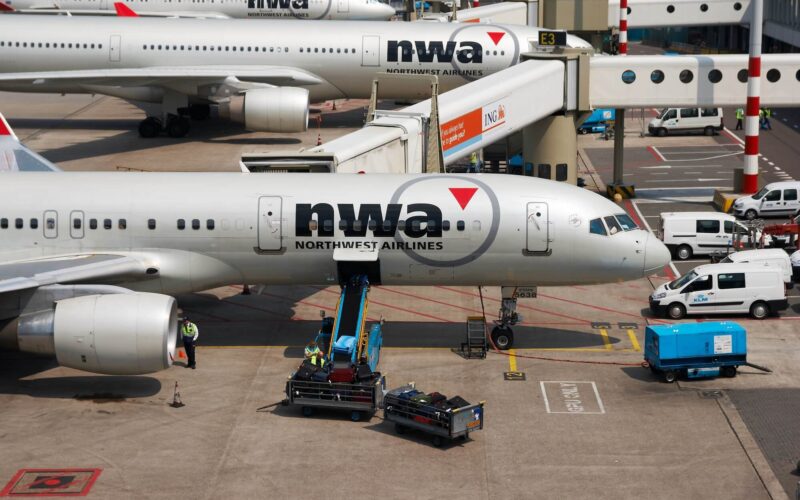With the aviation industry as competitive as ever, on-time performance (OTP) has never been more important.
The turnaround – the time between brakes-on after arrival and the doors closing for departure – plays a crucial role in achieving OTP and maintaining an on-time schedule for the entire day.
Before the wheels of an aircraft have even touched the ground, a parking stand has been allocated and a team of ground staff will be waiting to help prepare the aircraft for its next flight.
For long-haul airlines and larger aircraft, the turnaround time is between 90-120 minutes. For smaller aircraft and short-haul operations, the turnaround can be as short as 25 minutes and no longer than 40 minutes.
Speed, efficiency, and preparation are crucial for meeting schedules. Most airlines outsource ground-handling to contractors such as DNATA, DHL, and Swissport.
So, what exactly is involved in the turnaround?
Dispatcher
A dispatcher is responsible for coordinating the turnaround and ensuring all the tasks are completed within the turnaround time.
Before the aircraft arrives on stand, the dispatcher completes a safety inspection, ensuring the area is clear of Foreign Object Debris (FOD) which could cause damage to the aircraft.
Once the aircraft arrives, a marshaller will guide the aircraft onto the stand, ensuring it comes to a stop at the precise position for the aircraft type – note the yellow markings on a stand the next time you fly. This ensures wing tip clearance and is important for airbridges to precisely align with the main door.
Most airports today have an Advanced Visual Docking Guidance System – large screens attached to the terminal which have replaced the marshaller guiding the pilots.
Chocks and ground power
Once the parking brake is on, chocks are placed around the wheels and the turnaround countdown begins.
With the engines shut down, ground power is connected to the aircraft to power lights, instruments, and onboard systems.
At this time, ground equipment is moved to the aircraft. Passengers always use the left-hand side, and other equipment such as fuel, baggage, and catering use the right–hand side.
Disembarking
Stairs, an airbridge or both are connected to the aircraft and, if rear steps are used, a P.I.G. (Passenger Integrated Guidance system) is assembled to ensure passengers don’t walk underneath the wing or near the engines.
The dispatcher will meet the cabin manager on board to confirm where they have come from, the total number of passengers on board, and if any require special assistance to disembark.
With this information, the dispatcher ensures that the airport passenger assistance team have the aircraft on their list and if any buses are required to move passengers, and that the correct number are on the way.
Loading and refueling
Outside, baggage handlers open the forward and rear cargo holds to off-load baggage and cargo, while the bags for the next flight wait on baggage carts ready to be loaded.
To refuel aircraft, some airports have underground fuel tanks which simply need a truck to pump fuel up into the wings. For airports without underground fuel tanks, a refueling truck will upload the amount of fuel requested by the pilots.
A special vehicle empties the wastewater tank and fills up the fresh water tank ready for the next flight. Once all the passengers have disembarked, catering teams will upload any fresh food, ice and bars which are replenished between flights.
Aircraft cleaning
Back on board, the aircraft needs to be cleaned before the next flight. Rubbish is off-loaded and the cabin is checked for any lost property before being laid out for the next passengers. Seat belts are crossed over, and safety cards placed face on.
Airlines with a longer turnaround time will have a team of cleaners come on board. For short haul airlines though, this task is usually undertaken by cabin crew, with a mere eight minutes in which to do so between the final passenger stepping off the aircraft and the first passenger boarding for the next flight.
At the same time, either the captain or the first officer will complete an aircraft walk-around, checking for any leaks or damage to the airframe, particularly the engines, landing gear, sensors and flaps.
Final call
The dispatcher will close the outbound flight and print out the paperwork, detailing the number of passengers, any children or infants, the number of bags on board and any empty seats. This is then handed over to the cabin manager and, once the aircraft is cleaned and ready, boarding will begin.
Boarding
To help with the efficiency of the turnaround, passengers are usually ‘pre-boarded’, with passports and tickets checked before the aircraft is ready. Passengers are usually then taken down from the gate to the aircraft to await boarding.
Once all the passengers are on board and the bags are all loaded into the hold, separate paperwork is handed to the pilots detailing the final passenger load with weight and balance figures.
Three minutes to pushback
With three minutes to go until off-block time, the aircraft doors are closed and all ground equipment including steps and airbridges are removed from the aircraft in preparation for pushback.
Once the doors are armed and the aircraft is pushed back from stand, the ground team will move to the next stand and start over with another aircraft turnaround.
During this impressive process, completed in as little as 25 minutes, more than 300 passengers, 30,000 liters of fuel, hundreds of items of luggage and masses of catering supplies can be exchanged in all weathers at all times of the day in what is truly a non-stop operation.

